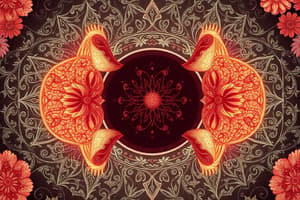Podcast
Questions and Answers
During which phase of mitosis do sister chromatids separate and move toward opposite poles of the cell?
During which phase of mitosis do sister chromatids separate and move toward opposite poles of the cell?
- Telophase
- Anaphase (correct)
- Prophase
- Metaphase
Which of the following accurately describes the product of mitosis?
Which of the following accurately describes the product of mitosis?
- Four genetically identical daughter cells.
- Four genetically distinct daughter cells.
- Two genetically distinct daughter cells.
- Two genetically identical daughter cells. (correct)
In which stage of mitosis does the nuclear envelope reform and chromosomes begin to decondense?
In which stage of mitosis does the nuclear envelope reform and chromosomes begin to decondense?
- Prophase
- Telophase (correct)
- Anaphase
- Metaphase
What is the primary function of mitosis in multicellular organisms?
What is the primary function of mitosis in multicellular organisms?
During which phase of mitosis do chromosomes line up along the metaphase plate?
During which phase of mitosis do chromosomes line up along the metaphase plate?
If a cell with 20 chromosomes undergoes mitosis, how many chromosomes will each daughter cell have?
If a cell with 20 chromosomes undergoes mitosis, how many chromosomes will each daughter cell have?
Which event typically occurs during prophase?
Which event typically occurs during prophase?
What is the role of the spindle fibers during mitosis?
What is the role of the spindle fibers during mitosis?
Cytokinesis typically overlaps with which phase of mitosis?
Cytokinesis typically overlaps with which phase of mitosis?
How does mitosis contribute to asexual reproduction?
How does mitosis contribute to asexual reproduction?
Which of the following is a key difference between mitosis and meiosis?
Which of the following is a key difference between mitosis and meiosis?
What is the significance of meiosis in sexual reproduction?
What is the significance of meiosis in sexual reproduction?
Which process leads to increased genetic variation in gametes during meiosis?
Which process leads to increased genetic variation in gametes during meiosis?
What is the role of gametes in sexual reproduction?
What is the role of gametes in sexual reproduction?
If a diploid cell has 40 chromosomes, how many chromosomes will each of its gametes have after meiosis?
If a diploid cell has 40 chromosomes, how many chromosomes will each of its gametes have after meiosis?
What is a karyotype, and what information does it provide?
What is a karyotype, and what information does it provide?
What process is underpinned by mitosis in asexual reproduction?
What process is underpinned by mitosis in asexual reproduction?
Which of the following statements correctly contrasts events in plant and animal cells during cytokinesis?
Which of the following statements correctly contrasts events in plant and animal cells during cytokinesis?
When observing a cell under a microscope, you notice that the chromosomes are condensed, and the nuclear envelope is disappearing. In which phase of either mitosis or meiosis might you be observing this cell?
When observing a cell under a microscope, you notice that the chromosomes are condensed, and the nuclear envelope is disappearing. In which phase of either mitosis or meiosis might you be observing this cell?
Which of the following is a direct result of sexual reproduction?
Which of the following is a direct result of sexual reproduction?
Flashcards
Mitosis
Mitosis
The process of cell division that results in two identical daughter cells; basis of asexual reproduction.
Meiosis
Meiosis
Nuclear division resulting in four genetically different cells with half the number of chromosomes; basis of sexual reproduction.
Interphase
Interphase
Cell is carrying out its normal life activities, chromosomes become duplicated
Early Prophase
Early Prophase
Signup and view all the flashcards
Late Prophase
Late Prophase
Signup and view all the flashcards
Metaphase
Metaphase
Signup and view all the flashcards
Anaphase
Anaphase
Signup and view all the flashcards
Telophase
Telophase
Signup and view all the flashcards
Asexual Reproduction
Asexual Reproduction
Signup and view all the flashcards
Sexual Reproduction
Sexual Reproduction
Signup and view all the flashcards
Gametes
Gametes
Signup and view all the flashcards
Karyotype
Karyotype
Signup and view all the flashcards
Study Notes
- A quick review of mitosis, its function, what logically has to happen, and the steps (PMAT) is important when studying meiosis.
Stages of Mitosis
- Mitosis includes interphase, early prophase, later prophase, metaphase, anaphase, telophase, interphase, and cytokinesis
- Interphase cells carry out normal activities, and chromosomes duplicate.
- Early prophase cells see the nuclear envelope and nucleolus disappear, chromatin becomes visible.
- Late prophase chromosomes shorten and thicken; the spindle forms, centrioles move to opposite poles, kinetochores attach to microtubules.
- Metaphase sees spindle fibers attach to the kinetochores of chromosomes, lining them up on the cell's midplane.
- During anaphase, chromatids separate at centromeres, and a group of chromosomes moves toward each opposite pole.
- Telophase sees chromosomes arrive at the poles, nuclear envelopes form, producing two daughter cells after cytokinesis.
- Daughter cells formed are genetically identical to the parent cell.
- Cytokinesis involves a cleavage furrow in animal cells and the formation of a cell plate in plant cells.
Asexual Reproduction
- Offspring from asexual reproduction have hereditary traits identical to a single parent.
- Mitosis is the basis of asexual reproduction.
Sexual Reproduction
- Sexual reproduction leads to the creation of a fertilized egg or zygote when the gametes join.
- Meiosis serves as the foundation for this process.
Functions of Meiosis
- The function of meiosis is to make haploid gametes, such as eggs and sperm.
- Meiosis is the reason for individual variability.
- Gametes from different parents can eventually join to produce a fertilized egg, also known as a zygote.
Karyotype
- A karyotype is a picture of the overall structure and size of the chromosomes in a genome.
- A karyotype includes homologous chromosomes, centromeres and sister chromatids.
Studying That Suits You
Use AI to generate personalized quizzes and flashcards to suit your learning preferences.


